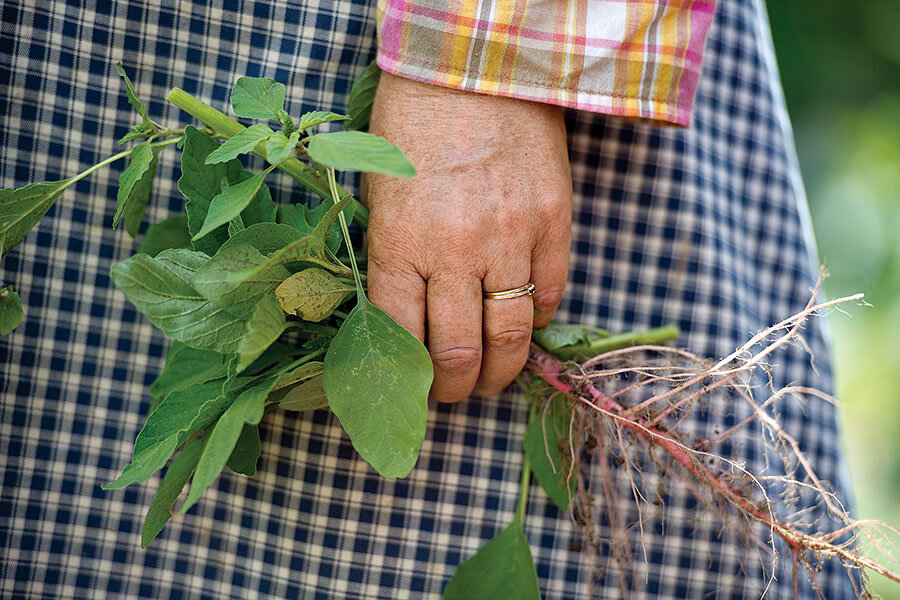Veteran gardener’s tips on weed control
Loading...
Weeds are more than plants growing where you don’t want them growing. They outcompete the plants you do want. Weeds gobble up nutrients and moisture; they overrun less vigorous neighbors; they may harbor diseases and pests.
After decades of gardening, I’ve learned that a weed-control strategy must be realistic: I focus on getting the upper hand, not on extermination. Annual weeds, such as witchgrass, sprout and die in one season; biennials, such as wild carrot, live for two seasons. But before these weeds croak, they produce huge numbers of seeds: One pigweed can set 300,000 seeds.
When they’re small, annual and biennial weeds are fairly simple to pull, dig up, or kill with a hoe. Control is harder as they grow, and once they go to seed, you’re back at Square 1. The best way to get rid of weeds is to never let them set seed.
Field bindweed, dandelions, and other perennial weeds that persist from year to year are more challenging. They set seeds but also spread via shoots above and below ground. Their well-developed roots make them difficult to pull or dig up, and any bit of root left behind will sprout. But if you keep slicing perennial weeds off at the soil line, their roots eventually die.
Holding sway over weeds is easier if you begin with a weed-free bed. The sun can help you with this and kill soil pathogens as well. The process, called solarization, requires heating the soil by covering it with clear plastic. Instructions from gardening expert Nan Sterman are available at http://bit.ly/SolarizeSoil.
Other weed-preventive measures:
•As much as possible, make sure that what you add to the garden – soil, compost, manure, mulch – is free of weed seeds.
•Don’t leave soil bare. It’s an invitation for weeds.
•Limit cultivating, or turning, the soil, which brings dormant weed seeds to the surface where they germinate.
•Intercrop (grow two or three crops in proximity) in the vegetable garden to keep soil covered, or plant a “green manure” (nitrogen-fixing crop) like white clover.
•Fertilize and water individual plants, not the entire garden.
•Edge the garden so that lawn grasses don’t creep in.
•Don’t compost weeds. Compost piles rarely get hot enough (140 degrees F.) to kill most weed seeds.
•Use mulch. Eliminating light inhibits germination. Synthetic mulches, such as landscape fabrics and plastics, suppress weeds but carry environmental drawbacks. Stones and other mineral mulches must be underlaid with a landscape fabric in order to suppress weeds. Best are organic mulches, such as pine straw, shredded leaves, grass clippings, and shredded bark. They smother weeds and improve the soil as they break down.
You can boost the effectiveness of organic mulches with newsprint. Wet the ground, put down four to 10 pages of newsprint (no glossy paper), wet them, and cover with 2 to 4 inches of mulch.
As for hand-to-hand combat with weeds, racing to the garden with a pot of boiling water to scald them has obvious drawbacks. Nor am I inclined to strap on a propane backpack to torch them.
What about herbicides? The hazards of synthetic poisons are now so well documented that responsible gardeners have put them aside. There are commercial “green” herbicides made from essential oils and fatty acids. All are nonselective, killing flowers and vegetables as well as weeds. They affect only leaves and stems, so many weeds quickly resprout.
Popular homemade bleach- or vinegar-based foliar sprays also have liabilities. Bleach raises soil pH and adds sodium to the soil. USDA data show that kitchen vinegar is too weak to be very effective, and repeated spraying acidifies the soil.
So enlist the gardener’s best weed-control tools: a pair of hands (covered with good, grippy, flexible gloves), a three-tined hand cultivator, and a scuffle (stirrup) hoe, with its double-edge blade designed to push and pull along the soil surface.
Repeated use of these tools won’t eradicate all weeds, but in time will eliminate so many that friends will ask incredulously, “Why aren’t there any weeds in your garden?”







